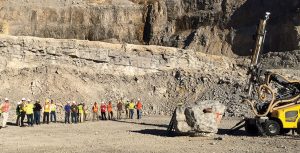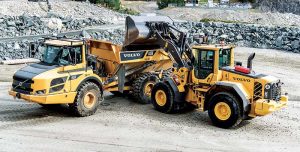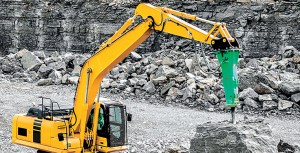Author
Vulcan hosts technology, equipment quarry event
Top industry professionals participate in shared technology updates with live demonstrations at a Vulcan Materials quarry. Keep Reading
Platform features optimize productivity, reduce costs
New platform features are designed to optimize mining productivity and reduce operating costs. Keep Reading
Volvo introduces innovations at Xploration Forum
Volvo CE showcased a range of futuristic concepts and leading-edge innovations for the aggregate industry. Keep Reading
Preventing belt accidents
Special precautions at conveyor areas can reduce serious incidents. Keep Reading
Canoe liners boost throughput for sand-and-gravel producer
Impact- and abrasion-resistant canoe liners help boost throughput at Fisher Industries. Keep Reading
New hydraulic breakers increase efficiency, longevity
To an outsider, splitting oversized boulders and busting rock walls may appear cut-and-dried. However, to those in the aggregates industry, it’s a much different reality. They’ve seen firsthand the difference a well-designed hydraulic breaker can make to the speed, efficiency and safety of their work. It’s this drive to get the job done right and on time that has propelled equipment manufacturers to continue to apply innovative techniques and technologies to the design of the modern hydraulic breaker. “Innovation in breaker technology and design has largely been driven by two things – operator desire for speed and changes to the carriers themselves,” says Paul Shevlin, territory manager for Montabert, a breaker manufacturer. “Excavators, skid-steers and track loaders keep getting stronger and more efficient, generating a demand for stronger, more efficient attachments. The same carrier that once could handle only a 750-ft.-lb. breaker could easily handle a 1,000-ft.-lb. model today.” Three advances in particular illustrate the increasing sophistication of hydraulic breakers: variable-speed design, blank-firing protection technology and automatic lubrication systems. Variable-speed… Keep Reading
Wheel loader tire tips for increased production
1. Maintain proper tire pressure to maximize loader productivity. Incorrect tire pressure always slows a loader’s total work cycle. Low front tire pressures promote excessive side-to-side motion as the boom is raised, leading to slower cycle times. Higher-than-required rear-tire pressures contribute to poor fore-aft stability and slow cycle times. Operators may think the machine needs more rear counterweight as their rear tires tend to bounce, but additional counterweight cannot overcome incorrect tire pressures. 2. Match tire pressures to the application. Damp sand weighs a lot and can reach as much as 120-percent bucket fill, while a load of large, clean 2-in. to 18-in. rock weighs less and may reach only 80-percent bucket fill. Default tire pressures in your operator’s manual may not be right for the material you’re loading. Refer to your tire manufacturer’s load/pressure tables or contact your equipment dealer for proper inflation pressure by application. Proper inflation provides a high level of traction and longer tire life by maintaining as large a contact area between the tire and… Keep Reading
Reducing waste stockpiles
Caribbean producer C.O. Williams installed a new wash plant to process material from an existing crushing operation at its Lears Quarry in Barbados. The company operates a 250-tph crushing plant that processes coral limestone. This produces more than 35,000 tons of aggregates per month, in addition to the more than 18,000 tons of asphalt the company makes each year. The existing crushing plant produces a large quantity of minus 1/4-in. material with very high fines content, which was stockpiled as a waste product on site. “The waste from the crushing operations was an ongoing concern for us, and the high fines content required that we look at a wash plant to see if we could recover any material that could be used either as construction sands or in our own asphalt production” says Neil Weekes, general manager for C.O. Williams. There are waste stockpiles approaching 500,000 tons of the minus 1/4-in. material, and the crushing plant produces another 500 tons of it per day. An analysis of the waste stockpiles… Keep Reading
HSI on the move
A Texas company uses a track-mounted impactor to process virgin aggregates, as well as recycled building materials. Producers crushing on the run know there are two key ingredients to running any successful contracting business: versatility and reliability. For Mesa Equipment Co., a family-owned and operated construction company in San Antonio, an investment in a new horizontal shaft impactor (HSI) provided the capability to tackle any crushing job that came their way. The company first began renting the HSI when it was hired to excavate a site and process material for the erection of a new Sam’s Club warehouse, says James Murry, son of company founder D.A. Murry, who runs the business with James and his two other sons, Paul and Kevin. Mesa Equipment has served the San Antonio area since the early 1980s, and has been crushing and screening for the past 15 years. “In the past, we’ve used other crushers where you’ve had to have a screen behind it to produce a finished product,” James Murry says. “We like… Keep Reading














